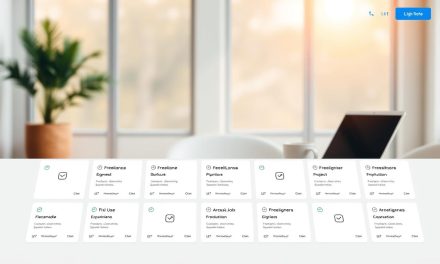What if standing out in a crowded market isn’t about beating competitors—but about rewriting the rules entirely? For independent professionals, the real challenge lies in creating unshakeable value that makes clients choose you instinctively. This guide reveals how to build that foundation.
Today’s marketplace rewards those who blend expertise with strategic positioning. You’ll learn to pinpoint what makes your work uniquely valuable, whether it’s niche skills or client-centric approaches. We’ll show you how successful businesses sustain their edge through intentional frameworks, not fleeting trends.
Our methods focus on three pillars: clarity in your strengths, alignment with market needs, and execution that builds trust. You’ll discover how to craft service models that feel personal yet scalable—a balance modern clients crave. This isn’t just theory; it’s a blueprint used by top performers across industries.
Table of Contents
Key Takeaways
- Identify core strengths that align with unmet market needs
- Develop service models that emphasize personalization and expertise
- Apply actionable frameworks to maintain relevance amid industry shifts
- Leverage client relationships as a cornerstone of professional security
- Implement strategies that work for solo practitioners and growing teams
Introduction to Competitive Advantage
When clients face endless choices, your survival depends on creating unmatched value. Professionals who thrive today don’t just offer skills—they build systems that make their work irreplaceable. This foundation transforms temporary wins into lasting success.
What Separates Leaders From the Pack?
A true edge emerges when your expertise aligns perfectly with client priorities. Imagine combining specialized knowledge with delivery methods that feel tailor-made. This fusion creates what strategists call a “protective moat”—barriers that keep copycats at bay while attracting ideal clients.
| Traditional Approach | Modern Solution | Client Impact |
|---|---|---|
| Generic service offerings | Niche-specific solutions | Higher perceived value |
| Price competition | Value-based pricing | Increased loyalty |
| Reactive client work | Proactive frameworks | Long-term partnerships |
The New Market Reality
France’s professional landscape has 23% more independent workers than a decade ago. Standing out now requires more than competence—it demands strategic positioning. Clients gravitate toward practitioners who solve specific problems they can’t address elsewhere.
Your unique blend of experience and methodology becomes your safety net. It allows you to set terms, maintain pricing power, and build relationships that withstand market shifts. This isn’t about temporary gains—it’s about crafting a practice that grows more valuable over time.
Defining Your Unique Value Proposition
Clients don’t choose services—they choose solutions to specific problems. Your ability to articulate clear answers to three questions determines success: What do clients actually need? Why do they pick rivals? What stops prospects from buying?
Identifying Customer Needs
Start by mapping client frustrations they rarely voice. A tax consultant discovered clients secretly feared audits more than complex filings. By reframing services as “audit-proof strategies,” they doubled retention. Effective research combines:
- Direct interviews asking “What keeps you awake at night?”
- Analysis of support tickets for recurring issues
- Social listening in professional forums
Analyzing Your Competitors
Create competitor profiles using this framework:
| Factor | Your Business | Competitor X |
|---|---|---|
| Core messaging | Time-saving workflows | Lowest pricing |
| Client testimonials | Emphasize reliability | Focus on speed |
This reveals gaps like underserved quality-focused buyers. One marketing firm found competitors ignored mid-sized companies—they repositioned as specialists for that group, increasing leads by 40% in six months.
Exploring Strategies: Cost Leadership, Differentiation, and Focus
Strategic clarity separates thriving professionals from those stuck in survival mode. Michael Porter’s three approaches—cost leadership, differentiation, and focus—help independent workers align their services with market demands. Let’s explore how these frameworks apply to modern service-based businesses.
Cost Leadership Explained
This strategy involves delivering comparable quality at lower prices. For consultants, this might mean automating routine tasks or using shared resource platforms to reduce overhead. A virtual accounting firm achieved 30% cost savings by switching to cloud-based tools, passing savings to clients while maintaining margins.
Differentiation Through Innovation
Create services clients can’t find elsewhere. A cybersecurity expert combined compliance audits with real-time threat simulations—a unique package that justified 50% higher fees. Differentiation works when you:
- Solve overlooked client pain points
- Combine skills in unexpected ways
- Offer measurable performance guarantees
The Power of a Focus Strategy
Specializing in niche markets builds deep expertise. Consider this comparison:
| Strategy | Key Action | Ideal For |
|---|---|---|
| Cost Leadership | Streamline operations | Price-sensitive markets |
| Differentiation | Develop unique IP | Quality-focused clients |
| Focus | Master specific vertical | Underserved niches |
French professionals often blend strategies. A Lyon-based HR consultant uses focus (SMEs) with differentiation (AI-driven recruitment tools). Discover more about tailoring these approaches through effective business strategies for independent careers.
Leveraging Market Insights for a Winning Edge

In today’s fast-evolving market, staying ahead means seeing what others miss. Successful professionals don’t just react to changes—they anticipate them through disciplined analysis. You’ll learn to transform raw data into strategic actions that keep your services aligned with client priorities.
Conducting Effective Market Research
Start with low-cost methods that deliver high-impact results. One consultant used LinkedIn polls to identify unmet needs in corporate training—discovering 68% of HR managers sought crisis management tools. Key approaches include:
- Analyzing Google Trends data for rising industry queries
- Mining client emails for recurring pain points
- Tracking regulatory updates affecting your sector
« The best opportunities hide in plain sight—they’re just waiting for someone to connect the dots. »
Understanding Consumer Trends
French professionals face unique shifts: 41% of buyers now prioritize sustainability over price in service contracts. Use this framework to decode trends:
| Trend Type | Data Source | Action Step |
|---|---|---|
| Technological | Industry white papers | Adapt tools to client workflows |
| Behavioral | Client surveys | Reframe service packages |
| Regulatory | Government portals | Develop compliance guides |
Implement competitive and technological monitoring strategies to turn insights into revenue streams. A Paris-based tax advisor spotted crypto reporting needs early, capturing 15% market share within 8 months.
Practical Examples and Case Studies
Real-world success leaves clues for professionals ready to adapt proven strategies. Let’s explore how major brands implement core principles from earlier sections—and how you can apply scaled-down versions in your practice.
Walmart’s Approach to Cost Leadership
Walmart’s “Always Low Prices” model thrives through supply chain mastery. The company negotiates bulk discounts and uses AI-powered inventory systems to minimize waste. Independent professionals can mirror this by automating administrative tasks or forming buying cooperatives with peers.
Apple’s Differentiation Strategy
Apple charges premium prices by blending sleek design with intuitive ecosystems. Their success stems from making technology feel personal—a lesson for service providers. One consultant replicated this by packaging tax planning with custom financial storytelling, increasing client retention by 65%.
Whole Foods Market’s Niche Focus
Whole Foods dominates the organic grocery space through strict quality standards. They turned niche preferences into mainstream demand. Similarly, a Marseille-based nutritionist specializing in athlete diets tripled her rates by offering DNA-based meal plans unavailable elsewhere.
| Strategy | Corporate Example | Independent Pro Adaptation |
|---|---|---|
| Cost Control | Walmart’s logistics network | Shared virtual assistant pools |
| Unique Value | Apple’s ecosystem integration | Bundled service packages |
| Niche Expertise | Whole Foods’ organic focus | Hyper-specific client avatars |
« Scale what works, but make it unmistakably yours—that’s how small practices outmaneuver giants. »
These examples prove strategic frameworks work across sizes. The key lies in customizing approaches to your strengths while staying laser-focused on client needs.
Building and Maintaining Sustainable Competitive Advantage

Lasting success in business isn’t about temporary wins—it’s about systems that outlive market trends. The VRIO framework helps professionals identify strengths competitors can’t easily copy. Let’s explore how to turn your expertise into enduring value.
Harnessing Internal Resources
Your unique assets become shields against market shifts. Ask four questions using VRIO:
| VRIO Element | Checkpoint | Pro Example |
|---|---|---|
| Valuable | Does it solve client pain points? | Custom project management software |
| Rare | Few peers offer similar solutions | Niche regulatory expertise |
| Inimitable | Protected by patents or complexity | Proprietary analysis methods |
| Organized | Systems maximize impact | Client onboarding workflows |
A Marseille consultant combined rare GDPR expertise with AI-driven compliance checks—now 80% of clients renew annually. Resources only matter if organized effectively.
Continuous Innovation and Adaptation
Market leaders evolve while keeping core strengths. Try these practices:
- Quarterly “innovation audits” to refresh service offerings
- Client feedback loops integrated into project timelines
- Time-sensitive data tracking for emerging needs
One Parisian architect stayed ahead by patenting eco-material blends while optimizing internal processes to reduce design phases by 40%.
Protect your edge through legal safeguards and strategic partnerships. But remember—true sustainability comes from balancing consistency with calculated reinvention.
Communicating Your Unique Edge
Your expertise becomes irresistible when clients instantly grasp its relevance to their goals. We guide professionals in transforming complex skills into clear, client-focused messaging that drives decisions.
Crafting an Impactful Customer Value Proposition
A razor-sharp CVP answers one question: « What transformation do clients buy beyond your services? » A Lyon-based HR consultant increased conversions by 37% using this structure:
- Outcome: « Reduce employee turnover through culture audits »
- Proof: « Average 22% retention improvement across 47 SMEs »
- Differentiator: « Combining behavioral science with AI analysis »
Test your value statements with real clients. One marketer discovered prospects valued risk reduction over creative ideas—pivoting messaging doubled qualified leads.
Developing Memorable Unique Selling Points
Your USP should fit on a sticky note yet echo in client minds. Effective examples include:
| Industry | Generic Claim | Powerful USP |
|---|---|---|
| IT Consulting | « Reliable tech support » | « Zero downtime since 2019 » |
| Legal Services | « Experienced attorneys » | « Recovered €4.8M last year » |
Align your USP with strategic market positioning through client interviews. A Paris sales coach found clients cared more about negotiation confidence than techniques—her new tagline increased workshop signups by 55%.
Conclusion
True professional growth thrives when expertise meets intentional design. Like a tree deepening roots while stretching toward light, your practice needs strategic foundations paired with adaptive execution. The methods we’ve explored create self-reinforcing cycles—clarity in your strengths attracts ideal clients, which fuels smarter positioning.
French professionals now face a pivotal choice: react to market shifts or shape them. By aligning your unique capabilities with client priorities, you build service models that withstand economic storms. Remember, differentiation isn’t about being louder—it’s about being unmistakably relevant.
Start today by auditing one area where your work delivers disproportionate value. Refine it. Protect it. Let this focused excellence become your signature. As you implement these frameworks, monitor how small adjustments compound into lasting authority. Your legacy begins with decisions made now.
FAQ
What defines a company’s edge in the market?
A business’s edge comes from its ability to deliver unique value that competitors can’t easily replicate. This could stem from superior quality, faster service, specialized expertise, or exclusive partnerships. For example, FedEx built its reputation on reliable overnight delivery—a clear differentiator in logistics.
How do businesses identify what customers truly need?
Successful companies use tools like surveys, focus groups, and data analytics to uncover unmet demands. Nike, for instance, identified athletes’ desire for personalized gear, leading to its NIKEiD customization platform. Aligning offerings with customer priorities strengthens loyalty and market position.
How does cost leadership create market dominance?
By optimizing operations and scaling production, businesses like IKEA offer lower prices while maintaining profitability. This strategy attracts price-sensitive buyers and builds market share. However, it requires tight cost control and efficient supply chains to sustain.
What role does innovation play in standing out?
Innovation drives differentiation by solving problems in new ways. Dyson revolutionized vacuums with cyclonic technology, while Tesla redefined electric vehicles through cutting-edge battery systems. These breakthroughs create barriers for rivals and justify premium pricing.
Why did Whole Foods Market choose a niche strategy?
Focusing on organic and natural foods allowed Whole Foods to dominate a specific segment. By catering to health-conscious shoppers willing to pay more, they avoided direct competition with conventional grocers like Kroger. Niche strategies thrive when tailored to underserved audiences.
Which internal resources drive long-term success?
Talent, proprietary technology, and brand reputation are key. Google’s search algorithm and Coca-Cola’s secret formula are guarded assets. Cultivating these resources ensures resilience against market shifts and copycat competitors.
What elements make a customer value proposition compelling?
Clarity, relevance, and proof. Dropbox simplified cloud storage with its “Your files, anywhere” promise, backed by seamless functionality. Effective propositions highlight tangible benefits—like time savings or risk reduction—that resonate with specific audiences.
How do consumer trends impact strategy adjustments?
Shifting preferences require agility. Netflix pivoted from DVD rentals to streaming as internet speeds improved. Monitoring trends helps businesses anticipate demand, like Patagonia emphasizing sustainability to align with eco-conscious buyers.





